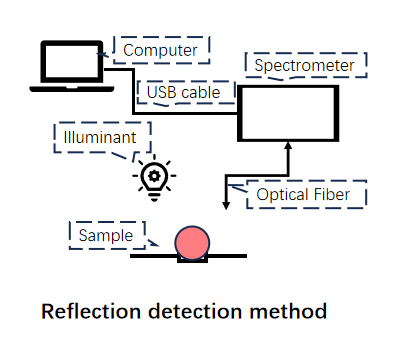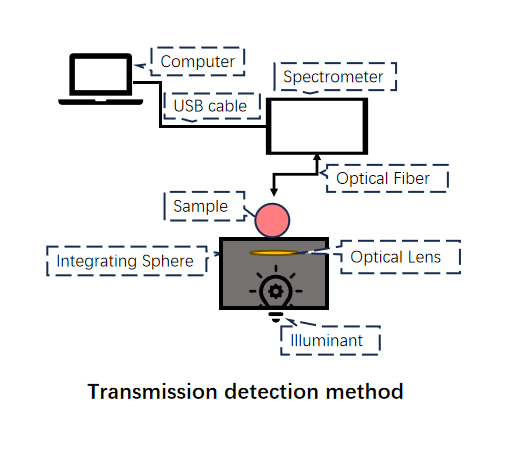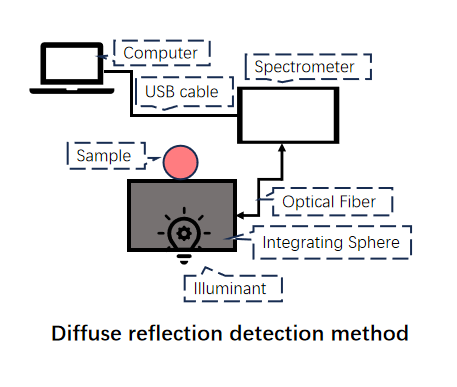1. Near-Infrared Spectroscopy in Fruit Applications
Near-infrared (NIR) spectroscopy, as a rapid and non-destructive testing method, has been widely used in fruit quality detection. With the increasing demand for fruit quality from consumers and the trend toward refined and standardized fruit production, NIR spectroscopy has gradually become an important tool in the field of fruit detection due to its unique advantages. This technology can quickly and non-destructively detect various internal components of fruits (such as sugars, acidity, and moisture) by measuring the spectral characteristics in the NIR region, providing a scientific basis for fruit quality assessment, grading, storage, and processing.
Quality Assessment:
By measuring the spectral characteristics of fruits, it is possible to predict quality parameters such as hardness, sweetness, and acidity, providing a scientific basis for fruit quality evaluation.
Classification and Identification:
Different fruits have distinct spectral characteristics. By comparing and analyzing spectral data, it is possible to differentiate and identify different fruit types.
Evaluation and Screening of Functional Fruits:
For functional fruits rich in special components, NIR spectroscopy can also be used for their evaluation and screening.
Disease Monitoring:
NIR spectroscopy can be used for the rapid diagnosis of diseases such as citrus greening disease, providing early warning for disease control.
2. Testing Principle
The NIR wavelength range, covering 780 to 2500 nanometers (nm), involves light absorption phenomena that directly trigger molecular vibrational responses. These molecular vibrations generate spectral data, where the specific characteristics of the spectrum are closely related to the chemical composition of the sample. In NIR spectral analysis of agricultural products, broad peaks are often observed due to the common presence of organic functional groups (such as C-H, O-H, N-H bonds) in the sample. These vibrational overtones and combination vibrations intertwine, leading to overlapping absorption spectra. Therefore, NIR spectra can not only outline the overall chemical characteristics of the sample but also reveal the presence of multiple components within a single spectrum, providing powerful technical support for quality analysis of agricultural products.
3. Testing Conditions
Light Source Conditions:
A stable NIR light source is required, with a wavelength range covering the NIR region (generally 780-2500nm) to ensure the excitation of hydrogen-containing groups in the fruit sample and the production of measurable spectral signals. A combination of single or multiple 50W halogen lamps can be used to increase both the light power and the illumination area and uniformity.
Fiber Conditions:
Fibers with large core diameters of 600, 800, or 1000 μm can be used to increase the light throughput.
Device Conditions:
The SR50R17 NIR fiber optic spectrometer, with a wavelength range of 900-1700nm, is suitable for non-destructive fruit testing due to its high accuracy and sensitivity.
Environmental Conditions:
During testing, environmental conditions such as temperature and humidity should be controlled to minimize their impact on the spectral signal.
4. Testing Methods
NIR Reflectance Detection Method:
This method is suitable for detecting information on the fruit's surface, such as color and gloss. However, since the reflected light mainly carries surface spectral information, it is not very effective for detecting internal quality.

NIR Transmission Detection Method:
Theoretically suitable for transparent or semi-transparent samples, but since fruits are whole and opaque solids, the transmission method cannot penetrate the sample and is therefore less used in practical applications.

NIR Diffuse Reflectance Detection Method:
A method that lies between reflectance and transmission, suitable for opaque, solid, and semi-solid samples. It is characterized by receiving light information that can fully reflect the internal structure of the fruit, making it widely used for detecting internal qualities (such as sugar content and acidity).
In conclusion, NIR fiber optic spectrometers have broad application prospects and significant practical value in fruit detection. With continuous technological development and improvement, they are expected to play an increasingly important role in fruit quality detection.

For more details, please visit: Near-infrared Fiber Spectrometer - JINSP Company Limited (jinsptech.com)
Post time: Jul-19-2024

